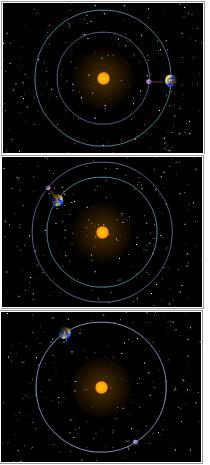Avi Blizovsky

Earth and spacecraft at the Lagrange points L1 (top), L2 (middle) and L3
for moving pictures
Direct link to this page: https://www.hayadan.org.il/mystery12.html
Summary
You often hear about L'Granz points, but what are these points really?
There are 5 points (actually orbits) in the Sun-Earth orbit where a third body with a small mass can stay in orbit while using a very small amount of fuel.
Point L1 is in a straight line between the earth and the sun, ideal for observing the sun, where the "Soho" satellite is now located. Another useful point is L2 which is located just further down the line behind the Earth (in the direction from the Sun). L2 is an excellent point for observing the universe without directly circling the Earth. Many of the upcoming planned space telescope missions are scheduled to be launched into this orbit in the coming years. Also there are 3 more points for additional Grenz L3, L4, L5.
The full story
Granz points are tracks in space where the gravitational forces and the tracks of the bodies balance each other.
The points were discovered by the French mathematician Louis L'Granz in 1772 in his study of gravity: "3-body problem" - how a small body will surround 2 other bodies that are in orbit.
There are five such points in the solar system - Earth. Similar points also exist in the Earth-Moon system.
L1
Kepler's laws dictate that the closer the star is to the sun, the greater its speed. Any spacecraft orbiting the Sun in an orbit more inner than the Earth will be bound by the above law and will not be able to remain in a fixed orbit relative to the Earth.
The L1 orbit is actually an annular orbit in which if the spacecraft finds itself between the Sun and the Earth, the gravitational pull of the Earth will equal the gravitational force coming from the Sun and thus cancel it. With a lower pull towards the sun, the spacecraft will need a lower speed to stay in orbit.
If the orbit is accurate - about a hundredth of the distance between the Earth and the Sun, the spacecraft will take exactly one year to orbit the Sun.
L1 is an excellent place for observations of the sun. The solar wind reaches it about one hour before it reaches the Earth. In 1978 Explorer 3 was launched into orbit and for several years made observations towards the sun. Now the "Soho" satellite is there.
Every spacecraft in this orbit must have rocket engines because the orbit is unstable, a small deviation from the orbit requires a correction to be made. In fact, the preferred place is also some distance from the orbit because if the spacecraft is exactly on the line between the earth and the sun, the antennas that follow the spacecraft from the earth will also be aimed exactly at the sun and there will be interference in the transmission.
L2
A similar effect, but exactly in the other direction, occurs in orbit L2 - on the "dark" side of the earth.
A spacecraft placed in this orbit will be farther from the sun and therefore should circle it in a period longer than a year. However, since the Earth's pull is added to the Sun's pull, this will allow the spacecraft to move faster and continue to track the Earth.
This point is about 1.5 million km from the Earth, about four times the distance of the Moon from the Earth.
L2 is an excellent place for observing the universe. The spacecraft is not required for a fixed orbit around the Earth where it is exposed to disturbances and heat change due to passing through the Earth's shadow and disturbances of heat radiation emitted from the Earth.
There are several missions planned for launch into this orbit in the coming years - Herschel, Plank, Gaia and the James Webb space telescope.
L3
This point is on a line between the sun and the earth but on the side behind the sun. The combination of the gravitational force of the Sun and the Earth will cause the spacecraft to complete an orbit around the Sun just like the Earth. Since this point is directly behind the Sun, any object located there is indistinguishable from Earth.
L4, L5
These points are on a line 60 degrees before and after the earth in its orbit from the direction of the sun. Unlike points L1, L2, L3 which are unstable (like a ball at the end of a hole and a slight movement will knock it down the slope), these points are stable. Any departure from the point will cause the object to rotate around the point. Therefore, objects also tend to collect in them, such as dust and asteroids.
The Sun's gravitational pull causes bodies in these locations to rotate around the L'Granz point in an 89-day cycle.
These places can be a place for space stations in the future.
For information on the Universe Today website
The series Mysteries of Space
On Lagrange points in Astropedia
On Kepler's Laws in Astropedia
https://www.hayadan.org.il/BuildaGate4/general2/data_card.php?Cat=~~~41541339~~~187&SiteName=hayadan

One response
What is the Granz line?